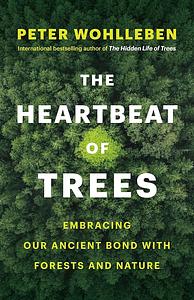Take a photo of a barcode or cover
254 reviews for:
The Heartbeat of Trees: Embracing Our Ancient Bond with Forests and Nature
Peter Wohlleben
254 reviews for:
The Heartbeat of Trees: Embracing Our Ancient Bond with Forests and Nature
Peter Wohlleben
challenging
emotional
hopeful
informative
inspiring
reflective
relaxing
sad
fast-paced
I enjoyed this audiobook very much as I painted a house. The facts and language are very accessible to the layman and quirky enough to hold my interest. I’m now following the author on social media, and look forward to more exploits.
hopeful
informative
inspiring
medium-paced
Of all things to expect, I did not expect Peter Wohlleben's ideas on nature to align with Robin Wall Kimmerer's. Both authors support the sentience of plant life and both are absolutely in awe of the world around us. While I have wondered if trees feel pain when their branches snap, when bark and leaves are stripped off by herbivores, or when we chop them down to use, I have never stopped to consider whether or not a tree or plant could perceive *me.*
It adds a whole new layer to Kimmerer's plea to respect all living beings.
It adds a whole new layer to Kimmerer's plea to respect all living beings.
I highly recommend the first book by this author called "The Hidden Life of Trees." This was not as good as this book, mostly because it was a collection of loosely connected anecdotes, and the beginning is harder to get through than the rest of the book. It was an enjoyable book to listen to as I drove carpools, commuted and did household chores.
hopeful
informative
inspiring
reflective
slow-paced
Interesting book but the delivery fell short, kind of like the author didn’t know what he wanted to do with it or where he wanted to end up. It starts off with disjointed fun facts about trees and turns into a rallying cry to protect the planet. All good stuff, just wish the pacing and messaging were consistent throughout
informative
reflective
relaxing
medium-paced
informative
reflective
relaxing
fast-paced
hopeful
informative
inspiring
I’ve read several books by the German author Peter Wohlleben, a conservationist and a fellow nature lover. My favourite is of course The Hidden Life of Trees. This book, The Heartbeat of Trees, is more chatty.
What I find new and interesting (to me):
– “Clues that the ability to see colours is closely tied to culture also exist in countries where European languages are spoken. People whose mother tongue is Russian recognise different shades of blue far more quickly than non-russian speakers, because Russian makes a clear distinction between dark blue and light blue.”
– Our hearing is worse than dogs’ but we are not all hopeless. Dogs have larger ear muscles so can pick up smaller volume sounds. Even our sense of smell is not as bad. We can pick up some smells better than dogs, such as fruits (dogs not interested in fruits). Because our gut can “smell” (have olfactory receptors), artificial compounds of scented candles, perfumes and other scented products can cause intestinal discomfort.
– Earthworms are not always angels of the forests. North America lost its earthworms in the last glacial period and trees have adapted to a world without earthworms. So, in North America, earthworms are invasive species. They damage forests and endanger many plant species.
– Tree huggers (myself included), Peter Wohlleben has bad news for you: trees can not feel your touch, definitely not through their barks. When you touch the leaves of a tomato plant and the plant stem grows stronger, it is not because she feels your love, but because she thinks you are wind therefore she needs to grow a stronger stem to fight against the windy weather. Sorry, grape vines can not distinguish classical music from rock music. You are just noise to be ignored. Possible reasons: we, as animals, are too fast for a tree; as a species, we have only existed for the 0.01% of time when trees have been existing, so, it is highly unlikely trees “know” who you are. Is there any sound that trees can hear? Yes, the munching sound of a caterpillar on its leaves. Some plant roots can “hear” the sound of water nearby and grow towards it.
I disagree with the author on following:
– It is still too early to say if the widespread nearsightedness in modern times is an evolutionary adaptation. It’s perhaps an adaptation to our environment but not a work of evolution.
– I am startled by the author’s assessment of the possible influence by mobile phone use on brain function. There have been many conspiracy theories out there on this matter. One must be extra careful when making such a claim, especially if one’s job is scientific communication.
Whether plants can “see”, “smell” or “feel pain”, it depends on the definition of these terms. Since scientists and philosophers still haven’t agreed upon what consciousness is, it is true one can not rule out the possibility.
Nature books are my comfort food. This book is no exception. However, in our era of climate change and mass extinction, one can not avoid depression and despair when it comes to nature conservation. I agree that “...many nature lovers harbour a deep desire not to be the one in charge of this planet.” But at least I can say this to Mr. Wohlleben: No, your book is not placed on the fiction shelf in my local bookstore, nor in Barnes & Noble. They are placed in the “science” section and many readers find them helpful.
What I find new and interesting (to me):
– “Clues that the ability to see colours is closely tied to culture also exist in countries where European languages are spoken. People whose mother tongue is Russian recognise different shades of blue far more quickly than non-russian speakers, because Russian makes a clear distinction between dark blue and light blue.”
– Our hearing is worse than dogs’ but we are not all hopeless. Dogs have larger ear muscles so can pick up smaller volume sounds. Even our sense of smell is not as bad. We can pick up some smells better than dogs, such as fruits (dogs not interested in fruits). Because our gut can “smell” (have olfactory receptors), artificial compounds of scented candles, perfumes and other scented products can cause intestinal discomfort.
– Earthworms are not always angels of the forests. North America lost its earthworms in the last glacial period and trees have adapted to a world without earthworms. So, in North America, earthworms are invasive species. They damage forests and endanger many plant species.
– Tree huggers (myself included), Peter Wohlleben has bad news for you: trees can not feel your touch, definitely not through their barks. When you touch the leaves of a tomato plant and the plant stem grows stronger, it is not because she feels your love, but because she thinks you are wind therefore she needs to grow a stronger stem to fight against the windy weather. Sorry, grape vines can not distinguish classical music from rock music. You are just noise to be ignored. Possible reasons: we, as animals, are too fast for a tree; as a species, we have only existed for the 0.01% of time when trees have been existing, so, it is highly unlikely trees “know” who you are. Is there any sound that trees can hear? Yes, the munching sound of a caterpillar on its leaves. Some plant roots can “hear” the sound of water nearby and grow towards it.
I disagree with the author on following:
– It is still too early to say if the widespread nearsightedness in modern times is an evolutionary adaptation. It’s perhaps an adaptation to our environment but not a work of evolution.
– I am startled by the author’s assessment of the possible influence by mobile phone use on brain function. There have been many conspiracy theories out there on this matter. One must be extra careful when making such a claim, especially if one’s job is scientific communication.
Whether plants can “see”, “smell” or “feel pain”, it depends on the definition of these terms. Since scientists and philosophers still haven’t agreed upon what consciousness is, it is true one can not rule out the possibility.
Nature books are my comfort food. This book is no exception. However, in our era of climate change and mass extinction, one can not avoid depression and despair when it comes to nature conservation. I agree that “...many nature lovers harbour a deep desire not to be the one in charge of this planet.” But at least I can say this to Mr. Wohlleben: No, your book is not placed on the fiction shelf in my local bookstore, nor in Barnes & Noble. They are placed in the “science” section and many readers find them helpful.





